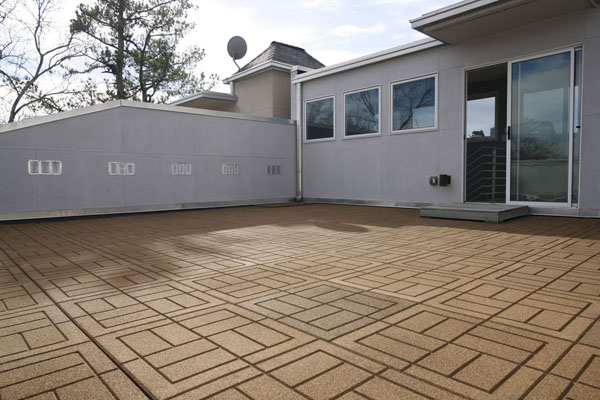Flooring using rubber tiles have become the trend nowadays replacing the old conventional ceramic tiles or granite tiles. Apart from being cheap as compared to ceramic or granite tiles, they have many additional advantages. They are slippage free, soft at the toe, durable, static-free, easy to maintain, and of course trendy. Generally they are applied at gyms and garages and office floors and lounges. Once dirty and old, they can be easily replaced by new ones. You can reuse such disposed rubber tiles to cover up your walkway to give it a touch of style and decor.

Difficulty Level
This project needs the involvement of an expert because it is directly related to the appearance of your living place. Hence, a well-finished work is desirable.
Time required
This depends on the area of your walkway which you need to cover up. Generally it takes one hour to fix 20-25 medium sized tiles.
Resources required
- Old removed rubber floor tiles
- Measuring tape
- Land marking powder
- Rubber tile fixing glue (may be epoxy based or acrylic based)
Price involved
The price of epoxy based glue is about $20-25 per jar. If you do not have a stock of old rubber tiles you can easily get it from a scrapyard seller at a very cheap cost.
Instructions
- First of all clean up the surface to be covered up. Make sure that it is free from dust, oil, paint, grease, or moisture. Or else the glue for fixing the tiles will not work. You can perform a pH test of the concrete sub-floor to check if there is any moisture, before applying the tiles.
- You can use your vacuum cleaner or any other dry cleaner to make the rubber tiles free from dust or moisture.
- Keep the tiles on the floor of your walkway for 3-4 days before starting the project so that they get adjusted with the ambient temperature and take the appropriate shape. This helps them to settle down easily on the surface when you finally place them.
- Next, use the measuring tape to measure and divide the total area of the walkway into equal divisions. Mark the divisions with the land marking powder.
- Now start placing the rubber tiles (without gluing them) from the corner at the farthest end of your walkway. Move back as you keep laying down the tiles. Fill up the tiles in a pyramidal pattern. See to it that the tiles are properly aligned as you lay them. In this way you will always have a way to escape and take rest for some time without disturbing the tiles.
- Complete all the sections of the walkway and then have a close look at every part of it. Ensure that no tile is out of the way or has not been laid properly.
- Take the jar of glue and start fixing the rubber tiles. Pick up each tile and apply glue at the back portion. Then replace the tile in it’s place. It is suggested that you refer to the instructions about how to apply the glue given on its packing.
- Move back in the same pattern as you laid the tiles earlier, till you complete gluing all the rubber tiles.
Quick tips
- Rubber tiles tend to harden up if stored in a cool place. So it is better to keep them on the surface to be covered for 3-4 days so that they get adjusted with the surface temperature.
- You can place the rubber tiles in interlocking positions to ensure better grip between the adjacent ones.
- Make sure that the concrete surface which you want to cover up is smooth and even. Ensure that there is no protruding chunk of concrete anywhere in the walkway which would prevent proper placing of tiles.
- You can also add to the decor and style of your walkway by using rubber color.
Possible risks involved
- See to it that the height of all the tiles is the same from the ground level. Even a single protruding tile can make you stumble.
- Avoid using old rubber tiles whose surface has become too hard and smooth. Using such tiles in your walkway can make the latter slippery.
- Be careful to get rid of the last bit of moisture from the concrete surface before placing the tiles. Or else the moisture will make the glue ineffective.
Environmental aspect
Synthetic rubber is non-biodegradable. Thus it is better to recycle than to dispose it.
Conclusion
Rubber tiles are ideal for walkways and pavements owing to their anti-static and anti-slippery properties. Moreover, rubber tiling is an excellent option for the homeowner who wants a durable and affordable flooring.



